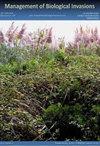Mercy or messy: distribution and differentiation of native and released Chinese bullfrogs (Hoplobatrachus rugulosus) in Hong Kong using genetic and morphological analyses
IF 1.2
4区 环境科学与生态学
Q3 BIODIVERSITY CONSERVATION
引用次数: 2
Abstract
The Chinese bullfrog, Hoplobatrachus rugulosus (Wiegmann, 1834), naturally distributed in Thailand, Laos, Vietnam and China, is commonly used in the religious practice of mercy release. The release of H. rugulosus is complicated by the fact that it likely represents a cryptic species complex (multiple species under a single name). In Hong Kong, although there are native and released individuals, the impact of release has not been investigated. In this study, we conduct genetic and morphological analyses of H. rugulosus across Hong Kong to determine the source (native or released) of frogs, the distribution of released populations and identify morphological characteristics that can be used to differentiate native and released individuals. We found that H. rugulosus individuals in Hong Kong belong to the two major genetic clades identified in previous studies (Clade A and Clade B). We consider individuals in Clade A as released frogs based on the genetic result that cluster these individuals with wild H. rugulosus from western, central and eastern Thailand, and individuals from Chinese frog farms. Individuals from the two genetic clades differ based on morphology (dorsal color, coloration of loreal region, presence of wounds and coloration on lateral sides), that can be useful for identification. However, there are four individuals in Clade A that are morphologically similar to native frogs, raising the possibility of hybridization between individuals in the two clades. We strongly recommend that the mercy release of H. rugulosus and other exotic animals should be strictly prohibited by law in Hong Kong and other parts of the world. Eradication guidelines should be developed by experts, as a references for governments, conservation groups and the public.仁慈还是混乱:利用遗传和形态分析香港本地和放生牛蛙(Hoplobatrachus rugulosus)的分布和分化
中国牛蛙Hoplobatrachus rugulosus (Wiegmann, 1834),自然分布于泰国、老挝、越南和中国,常用于宗教放生。H. rugulosus的释放是复杂的,因为它可能代表了一个隐蔽的物种复合体(多个物种在一个名字下)。在香港,虽然有本地和放生的个体,但放生的影响尚未被调查。在这项研究中,我们对香港各地的rugulosus蛙进行了遗传和形态学分析,以确定本地或释放蛙的来源,释放种群的分布,并确定可用于区分本地和释放个体的形态学特征。我们发现香港的rugulosus个体属于先前研究中确定的两个主要遗传分支(分支A和分支B)。基于将这些个体与来自泰国西部、中部和东部的野生rugulosus以及来自中国蛙场的个体聚集在一起的遗传结果,我们认为A分支的个体是释放的青蛙。来自两个遗传支系的个体在形态(背部颜色、耳区颜色、伤口的存在和侧面颜色)上有所不同,这对识别是有用的。然而,A枝中有4个个体在形态上与本地青蛙相似,这增加了两个枝中个体杂交的可能性。我们强烈建议,香港和世界其他地区应以法律严格禁止放生红毛猴和其他外来动物。专家应该制定根除指南,作为政府、保护组织和公众的参考。
本文章由计算机程序翻译,如有差异,请以英文原文为准。
求助全文
约1分钟内获得全文
求助全文
来源期刊

Management of Biological Invasions
Agricultural and Biological Sciences-Ecology, Evolution, Behavior and Systematics
CiteScore
3.40
自引率
6.70%
发文量
21
审稿时长
16 weeks
期刊介绍:
Management of Biological Invasions, established in 2010 by Dr. Elias Dana, is an open access, peer-reviewed international journal focusing on applied research in biological invasions in aquatic and terrestrial ecosystems from around the world. This journal is devoted to bridging the gap between scientific research and the use of science in decision-making, regulation and management in the area of invasive species introduction and biodiversity conservation.
Managing biological invasions is a crisis science, with Management of Biological Invasions aiming to provide insights to the issues, to document new forms of detection, measurements and analysis, and to document tangible solutions to this problem.
In addition to original research on applied issues, Management of Biological Invasions publishes technical reports on new management technologies of invasive species and also the proceedings of relevant international meetings. As a platform to encourage informed discussion on matters of national and international importance, we publish viewpoint papers that highlight emerging issues, showcase initiatives, and present opinions of leading researchers.
 求助内容:
求助内容: 应助结果提醒方式:
应助结果提醒方式:


